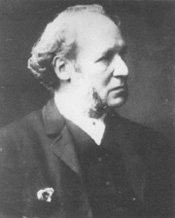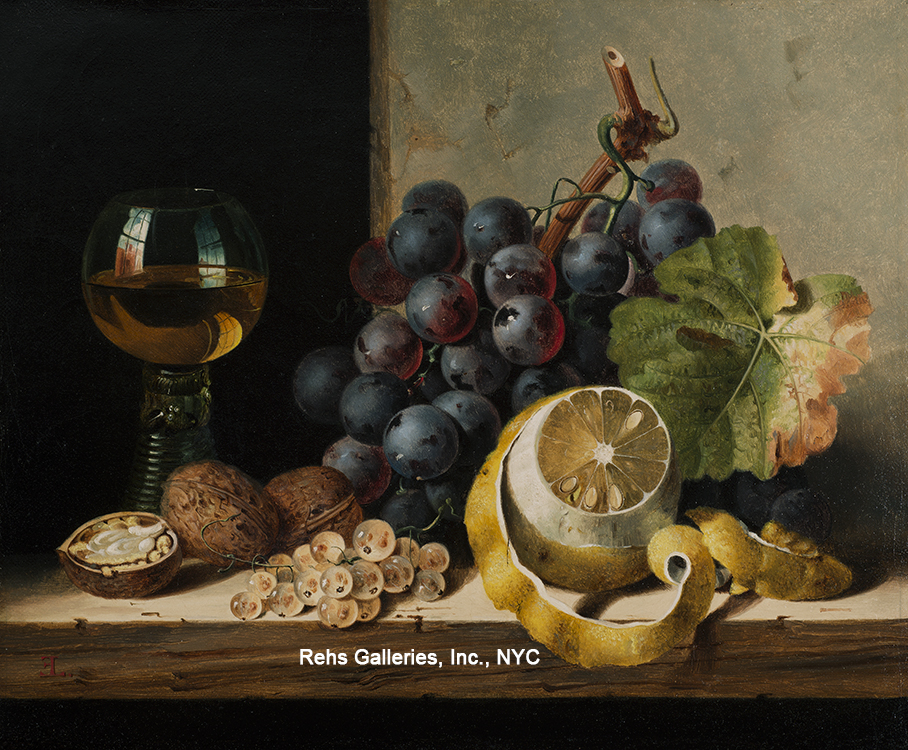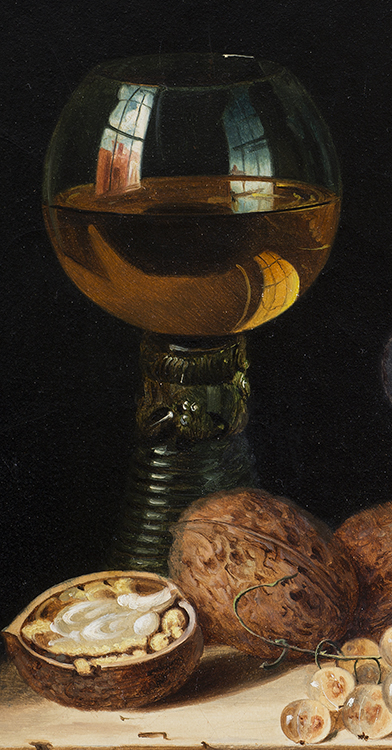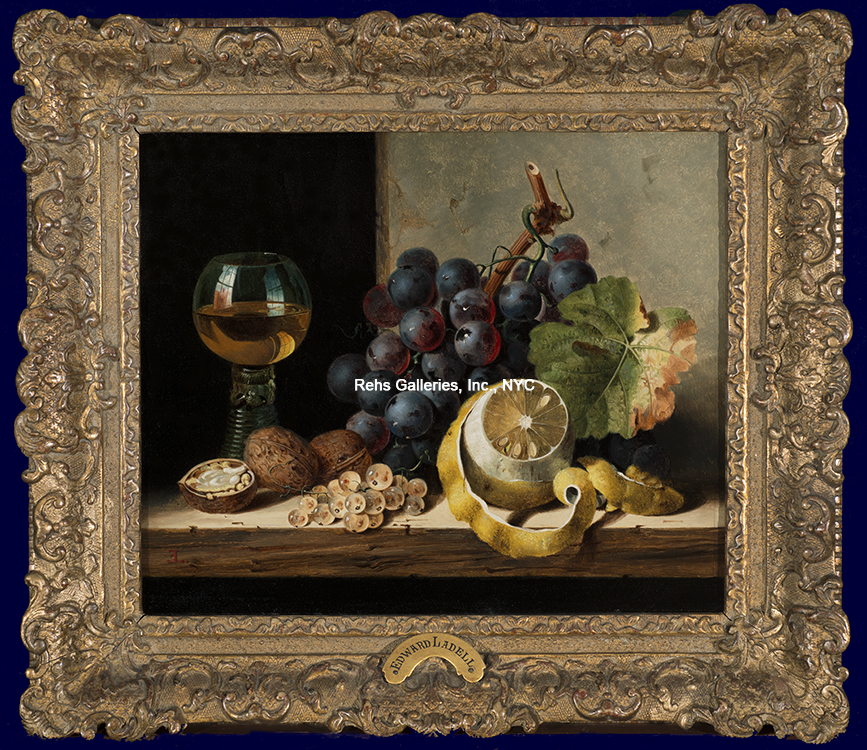Edward Ladell
(1821 - 1886)
Still Life
Oil on canvas
9 3/4 x 11 3/4 inches
Framed dimensions:
14 1/4 x 16 1/4 inches
Signed
BIOGRAPHY - Edward Ladell (1821 - 1886)

Still-life painter Edward Ladell was born in Hasketon, Suffolk on April 12, 1821, the same month that John Constable completed The Hay Wain (National Gallery, London) in East Bergholt approximately ten miles away. As a child growing up in a small Suffolk village, little is known about Ladell’s early art education, but it is tempting to wonder if he was aware of Constable’s work, and the increasingly famous painter from southeastern England. What might have been significant for the young Ladell was Constable’s lifelong discipline of drawing from nature, a habit that he clearly acquired in his own subsequent artistic career.
Much of what is known about Ladell’s early life comes from National Census records, which fortunately began to count the ages of children under twenty in the year that Ladell was born. Thus, there are records of his parents, Christmas and Mary Ladell, living in Hasketon as well as the information that his father owned his own coach-building business. There do not seem to have been any other living children.
Twenty years later, in 1841, the National Census records reveal that Ladell and his parents were living in the city of Cochester, Essex, also in southeastern England. [i] In July 1848, however, Ladell married Juliana Roope at the Parish Church of St. James, and moved to a new home in the East Hill neighborhood of Colchester. There Ladell seems to have worked as a reasonably successful engraver. Although it is generally assumed that Ladell was a self-taught artist, his work as an engraver seems to suggest that he received some type of formal training. One possibility is that he was apprenticed as a pattern designer to one of the Flemish textile companies that had been central to Colchester’s economy since the seventeenth century. Ladell’s father may well have cultivated ties to textile suppliers initially for his coach-building business, and then perhaps as an opportunity for his son to learn a trade.
Regardless of how he learned to paint, Ladell successfully submitted an oil painting, Study from Nature, to the Royal Academy exhibition in London in 1856. Three years later, in 1859, his work was again exhibited at the annual exhibition, and his career as a painter was well established. Despite the gaps in his biography during the first several decades of his life, it is evident that he was deeply familiar with the still-life paintings of the Dutch and Flemish schools of the seventeenth and eighteenth century. Perhaps his training as an engraver exposed him to still-life designs in textile pattern books, or perhaps he made regular visits to either museums or even private art collections. The railroad connection from Colchester to London, which opened in 1843, would have facilitated Ladell’s travels; it is also important to note that the painter was often described as an extroverted, good-natured man, probably someone who would have found visiting friends and colleagues a pleasant experience. His obituary in The Evening Post of Exeter (November 9, 1886) proclaimed that he was “a genial, warm-hearted friend, a charming companion, whose store of varied knowledge and natural ‘bonhomie’ made him always welcome...” [ii]
With steady acceptance at the Royal Academy exhibitions, Ladell listed himself as an “artist, oil painting” in the 1861 census; he and Julianna were still living in East Hill, Colchester, but they now had a daughter, Kate Elizabeth, who was born in 1860. Throughout the first half of the 1860s, Ladell painted his characteristic still-lifes, always with meticulous attention to detail and realism. Like the Dutch and Flemish still-life artists of earlier centuries, Ladell worked primarily for wealthy merchants for whom the still-life painting was an elegant addition to their homes. By 1865, however, some sort of unhappy circumstance seems to have developed in the painter’s life. He stopped submitting works to the Royal Academy, and in the 1871 census, he was listed as living alone at his home on East Hill. The disappearance of both his wife and daughter from the census record suggests either a serious illness or tragic accident of some sort. It was not until 1868 that Ladell began to exhibit his painting again.
During the 1860s, Ladell also decided to accept a handful of private students. The extent and scope of this instruction is not known, but his reputation as a still-life artist was widely respected by this time, and his temperament was undoubtedly well suited to teaching. One of his students was Ellen Maria Levett, who probably joined Ladell’s studio in the mid-1870s. She and Ladell married in October 1878 and moved to the seaside town of Torquay in Devon the following month. This would appear to have been a definitive change in Ladell’s life, not only marrying for a second time, but also moving away from the region that had always been his home. The stay in Torquay was very brief, as the newlyweds quickly moved 22 miles north to the city of Exeter where they made their home. In 1880, Ellen gave birth to a son, Kenwyn.
As his domestic life became more settled in Exeter, Ladell continued to expand his clientele through both regional exhibitions and the annual shows at the Royal Academy, the British Institute and the Suffolk Street Galleries in London. One particular work from the Royal Academy exhibition in 1880 attracted attention from a number of critics. Entitled simply Prawns, it seems to have captured the popular imagination. The art critic for the Devon Weekly Times (September 3, 1880) had this to say: “To begin with, there is among the oil paintings, a little gem by Mr. E. Ladell, which has just been exhibited at the Royal Academy. Mr. Ladell’s ‘Prawns’ is deservedly admired for it realism and its exquisite finish. The prawns themselves are quite tempting; and the manner in which the artist has succeeded in expressing the shades and reflections in the tinted wine glass and its contents is especially to be noted.” [iii]
Over the next six years, Ladell became a highly regarded member of the Exeter community. When he died after a brief respiratory illness on November 9, 1886, the local newspapers reflected a genuine sense of loss in the obituary. The Devon Evening Express (November 13, 1886) described the funeral in detail: “The whole of the circumstances connected with the funeral were, in a marked degree, expressive of the high esteem in which the deceased artist was held by those who had not only had the opportunity of recognizing his talent, but also of enjoying intercourse with one whose affability and kindness won for him the esteem of all with whom he was associated.” [iv] He is buried in the Higher Cemetery behind St. Mark’s Church, Exeter.
Janet Whitmore, Ph.D.
Selected Museums
Colchester and Ipswich Museums, Colchester Collection, Essex
Museum of Croydon, London
Mercer Art Gallery, Harrogate, North Yorkshire
Museums Sheffield, Sheffield, Yorkshire
Reading Museum, Berkshire
Touchstones Rochdale, Art Gallery, Rochdale, Lancashire
Royal Albert Museum, Exeter, Devon
[i] The only comprehensive study of Edward Ladell to date is the limited edition book by Frank Lewis, Edward Ladell, 1821-1886 (Leigh on Sea, Exeter: F. Lewis, Publishers, LImited, 1976).
[ii] The Evening Post, Exeter. p. 3, col. 3, Tuesday, November 9, 1886. Cited in Frank Lewis, Edward Ladell, 1821-1886, (Leigh on Sea, Exeter: F. Lewis, Publishers, LImited, 1976) 11.
[iii] Ibid., 18.
[iv] Ibid., 12.




